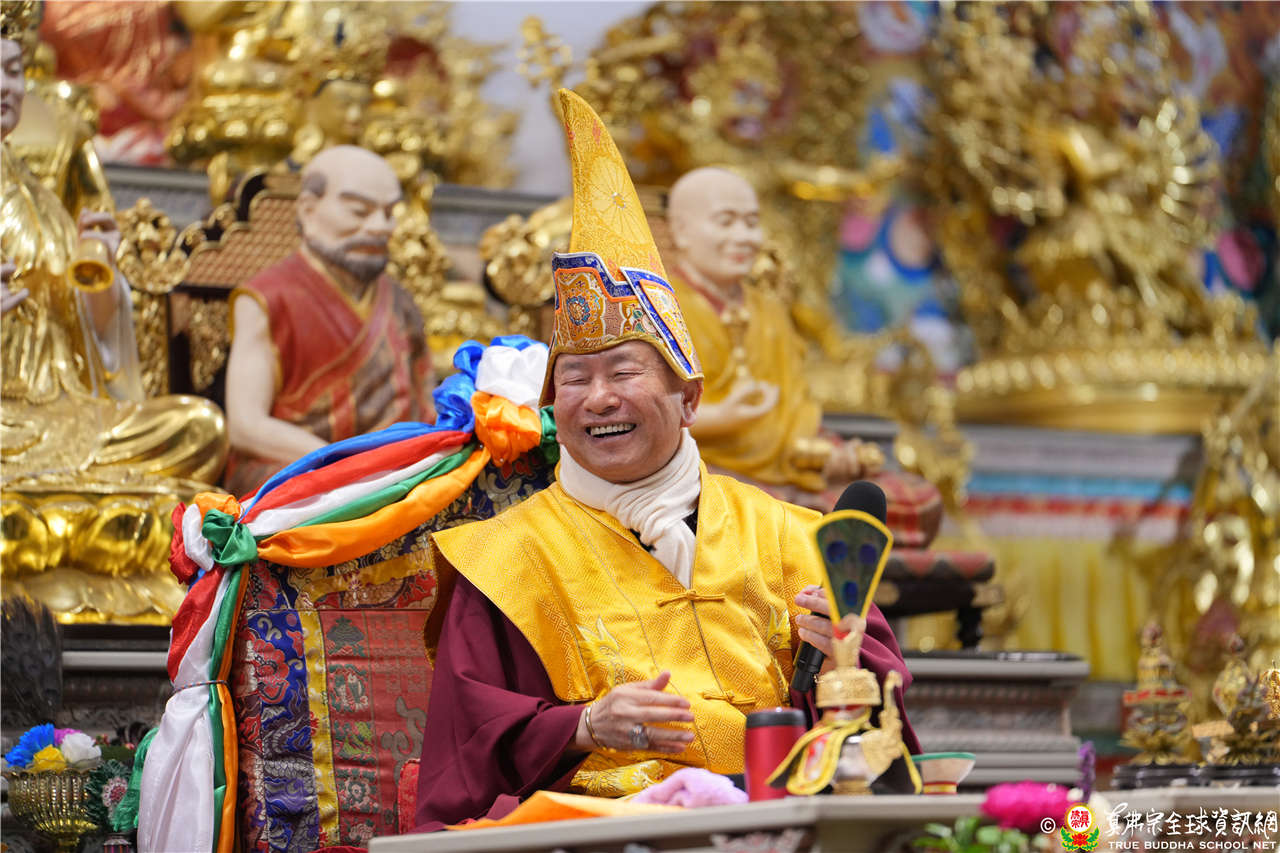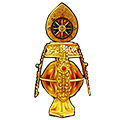
Vimalakirti Nirdesa Sutra
A Detailed Exposition by Living Buddha Lian Sheng, Grandmaster Sheng-Yen Lu
Translated into English by the True Buddha School Vimala Sutra Translation Team
Discourse 55, 24 December 2022 - Chapter One—Buddhaverse (Continued)
Chapter One—Buddhaverse
At that time in Vaisali City, there was an elder named Accumulated Treasures. Together with 500 (many) other elders, they came along with parasols embellished with the seven precious jewels, paid homage to the Buddha by touching his feet with their heads. They then made offering of those parasols to the Buddha.
By his divine might, the Buddha combined all the parasols into one parasol. The parasol contained the whole three-thousand-great-thousand worlds, with the Vast and Lasting One [Buddha] appearing at the center.
I will now talk about the Vimalakirti Sutra.
At that time in Vaisali City, there was an elder named Accumulated Treasures. Together with 500 (many) other elders, they came along with parasols embellished with the seven precious jewels…
Each of the elders brought a parasol, embellished with the seven precious jewels, to offer to Sakyamuni Buddha. I would like to elaborate more on the parasols. In ancient India, a great dharma teacher or a mahasiddha would always have a parasol above their head while giving dharma teachings. There are also parasols above many great bodhisattvas. They all have parasols above them. This symbolizes their attainments or accomplishments.
The Venerable Atisa, the key guru in the latter dharma propagation of Tibetan Buddhism, had many parasols above his head. How come? It was the custom in ancient India to debate. This custom spread to Tibet, where it is now called a sutra debate, and is adopted by the Tibetan lamas. Yet, they are not as common in the Central Plain Region. This custom came from India, and so did the Tibetan script, which is derived from Sanskrit.
Back then in India, the winner of a debate would receive a parasol and a temple, and the loser must take refuge in the winner. In this way, the Venerable Atisa accumulated many parasols and many temples. How come he had many keys hanging on his chest? People nowadays wouldn’t carry so many keys with them! But in ancient times, a mahasiddha carrying a key indicated that he owned a temple. The Venerable Atisa had so many keys on him that he walked with a clanking sound. At this sight, everyone could tell that he was a mahasiddha. He had won a lot of parasols, temples, and followers through his debating skills. That’s why he was a mahasiddha of his era. Subsequently, the King Yeshe-O and King Jangchub Ö sent envoys to invite the Venerable Atisa to disseminate buddhadharma in Tibet. That was the Latter Dissemination of Buddhism into Tibet. Hence, parasols were the tradition of India.
Many elders came with all their jewel-studded parasols to offer to Sakyamuni Buddha because Sakyamuni Buddha was a mahasiddha.
…paid homage to the Buddha by touching his feet with their heads.
Let me explain this part on the “homage by touching the feet of a mahasiddha with one’s head.” In ancient India, people pay homage to a highly respected mahasiddha by touching the feet of the mahasiddha with their head. It is also known as the “five-point body prostration.” The five points are the two knees and two hands that are on the ground and the head that touches the feet. This is called “homage by touching feet with one’s head.” Placing one’s head at the feet of a mahasiddha shows one’s respect and obeisance. This is a custom in India. The elders placed their heads at Sakyamuni Buddha’s feet, showing their subservience to the Buddha. Do you understand now?
Bill Gates knew that Asian immigrants work very hard and thus hired many high-tech talents and engineers from India to work for Microsoft. Now, Seattle is almost like an Indian town. Many of our neighbors are Indians and they often stroll in the neighborhood. You can see it for yourself when you come to Seattle. With their darker complexion, some of you might mistake them for African Americans, but no, they are Asian Indians. They typically have large eyes, and many Indian women are full-figured, as in the Indian standard of beauty, a voluptuous figure is considered more attractive compared to a slim one. If [Master] Huijun lived in Seattle, she’d be the little one; Seattle is very suitable for her. [laughing]
Do you know many Indian people visit the Seattle Leizang Temple to pray? At the temple, we enshrine the Hindu Trinity—Brahma, Siva, Visnu, and also Mahasri, Saraswati, Ganapati or Ganesh, Durga, Kali and others. Saraswati is the Goddess with Marvelous Sound. Mahasri is also known as Laksmi. We also have the elephant-headed fortune god Ganesh, and the monkey god Hanuman, too. Once the news spread, many ethnic Indians came to worship—perhaps they treat it as a Hindu temple.
They come to visit the temple and whenever they see me, men and women alike bow and place their heads at my feet. Many of them are our neighbors. Someone asked, “Why do they do that? What kind of custom is it?” This is called “touching the feet with one’s head.”
They then made offering of those parasols to the Buddha.
The Accumulated Treasures Bodhisattva came with all the elders carrying parasols embellished with the seven precious jewels and offered them to the Buddha—a long line of parasols. Sakyamuni Buddha transformed the many parasols into one big parasol.
The parasol contained the whole three-thousand-great-thousand worlds, with the Vast and Lasting One [Buddha] appearing at the center.
This passage meant that Sakyamuni Buddha manifested his transcendent power by combining and transforming the many parasols into one big parasol that covered the entire three-thousand-great-thousand worlds. The divine might of Sakyamuni Buddha was truly tremendous.
Look at the altar here. Are there any parasols? There is no parasol to be found anywhere because this is not ancient India. I suppose the Han Chinese do not use jewel-studded parasols. Oh? Is that so? We have a parasol on the sixth-floor altar. Now, is there anyone who can move the parasol from the sixth floor here with their transcendent power? No? Let me manifest some formless parasols then. Alright, there are parasols above the temple now. Take some pictures and you will see them. [Many people took pictures and indeed, captured images of parasols in the sky above the temple.]
Om mani padme hum.
Next discourse on the Vimalakirti Sutra: Discourse 56, 31 December 2022 - Chapter One—Buddhaverse (Continued)
Previous discourse on the Vimalakirti Sutra: Discourse 54, 17 December 2022 - Chapter One—Buddhaverse (Continued)
Index of links to all discourse on the Vimalakirti Sutra: https://en.tbsn.org/guidem/detail/2975/
Back to the main index page of all dharma discourse: https://en.tbsn.org/guidem/index
Full webcast of 2022.12.24 Mahapratisara Bodhisattva Homa Ceremony (Taiwan Lei Tsang Temple) and dharma discourse with English interpretation: https://youtu.be/HiZ7GNymDog




